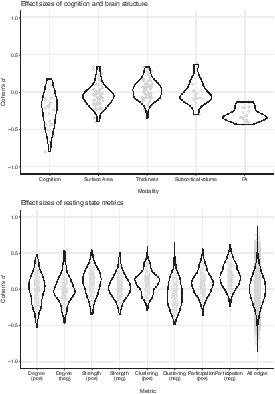当前位置:
X-MOL 学术
›
Hum. Brain Mapp.
›
论文详情
Our official English website, www.x-mol.net, welcomes your
feedback! (Note: you will need to create a separate account there.)
Associations of cannabis use disorder with cognition, brain structure, and brain function in African Americans
Human Brain Mapping ( IF 3.5 ) Pub Date : 2020-12-19 , DOI: 10.1002/hbm.25324 Marinka M G Koenis 1, 2 , Joke Durnez 3 , Amanda L Rodrigue 1, 4 , Samuel R Mathias 1, 4 , Aaron F Alexander-Bloch 1 , Jennifer A Barrett 2 , Gaelle E Doucet 5 , Sophia Frangou 5 , Emma E M Knowles 1, 4 , Josephine Mollon 1, 4 , Dominique Denbow 2 , Katrina Aberizk 2 , Molly Zatony 2 , Ronald J Janssen 1, 2 , Joanne E Curran 6 , John Blangero 6 , Russell A Poldrack 3 , Godfrey D Pearlson 1, 2, 7 , David C Glahn 1, 2, 4
Human Brain Mapping ( IF 3.5 ) Pub Date : 2020-12-19 , DOI: 10.1002/hbm.25324 Marinka M G Koenis 1, 2 , Joke Durnez 3 , Amanda L Rodrigue 1, 4 , Samuel R Mathias 1, 4 , Aaron F Alexander-Bloch 1 , Jennifer A Barrett 2 , Gaelle E Doucet 5 , Sophia Frangou 5 , Emma E M Knowles 1, 4 , Josephine Mollon 1, 4 , Dominique Denbow 2 , Katrina Aberizk 2 , Molly Zatony 2 , Ronald J Janssen 1, 2 , Joanne E Curran 6 , John Blangero 6 , Russell A Poldrack 3 , Godfrey D Pearlson 1, 2, 7 , David C Glahn 1, 2, 4
Affiliation

|
Although previous studies have highlighted associations of cannabis use with cognition and brain morphometry, critical questions remain with regard to the association between cannabis use and brain structural and functional connectivity. In a cross‐sectional community sample of 205 African Americans (age 18–70) we tested for associations of cannabis use disorder (CUD, n = 57) with multi‐domain cognitive measures and structural, diffusion, and resting state brain‐imaging phenotypes. Post hoc model evidence was computed with Bayes factors (BF) and posterior probabilities of association (PPA) to account for multiple testing. General cognitive functioning, verbal intelligence, verbal memory, working memory, and motor speed were lower in the CUD group compared with non‐users (p < .011; 1.9 < BF < 3,217). CUD was associated with altered functional connectivity in a network comprising the motor‐hand region in the superior parietal gyri and the anterior insula (p < .04). These differences were not explained by alcohol, other drug use, or education. No associations with CUD were observed in cortical thickness, cortical surface area, subcortical or cerebellar volumes (0.12 < BF < 1.5), or graph‐theoretical metrics of resting state connectivity (PPA < 0.01). In a large sample collected irrespective of cannabis used to minimize recruitment bias, we confirm the literature on poorer cognitive functioning in CUD, and an absence of volumetric brain differences between CUD and non‐CUD. We did not find evidence for or against a disruption of structural connectivity, whereas we did find localized resting state functional dysconnectivity in CUD. There was sufficient proof, however, that organization of functional connectivity as determined via graph metrics does not differ between CUD and non‐user group.
中文翻译:

大麻使用障碍与非裔美国人认知、大脑结构和大脑功能的关联
尽管之前的研究强调了大麻使用与认知和大脑形态测量之间的关联,但大麻使用与大脑结构和功能连接之间的关联仍然存在关键问题。在 205 名非裔美国人(18-70 岁)的横断面社区样本中,我们测试了大麻使用障碍(CUD, n = 57)与多领域认知测量以及结构、扩散和静息状态脑成像表型的关联。事后模型证据是使用贝叶斯因子 (BF) 和后验关联概率 (PPA) 计算的,以解释多重测试。与非使用者相比,CUD 组的一般认知功能、言语智力、言语记忆、工作记忆和运动速度较低 ( p < .011; 1.9 < BF < 3,217)。 CUD 与包括顶上回运动手区和前岛叶的网络功能连接改变相关 ( p < .04)。这些差异不能用酒精、其他药物使用或教育来解释。在皮质厚度、皮质表面积、皮质下或小脑体积 (0.12 < BF < 1.5) 或静息状态连接的图论指标 (PPA < 0.01) 中未观察到与 CUD 的关联。在为尽量减少招募偏差而收集的大量样本中,我们证实了有关 CUD 认知功能较差的文献,以及 CUD 和非 CUD 之间不存在大脑体积差异的文献。我们没有找到支持或反对结构连接破坏的证据,但我们确实发现了 CUD 中局部静息态功能连接障碍。 然而,有足够的证据表明,通过图形指标确定的功能连接组织在 CUD 和非用户组之间没有差异。
更新日期:2020-12-19
中文翻译:

大麻使用障碍与非裔美国人认知、大脑结构和大脑功能的关联
尽管之前的研究强调了大麻使用与认知和大脑形态测量之间的关联,但大麻使用与大脑结构和功能连接之间的关联仍然存在关键问题。在 205 名非裔美国人(18-70 岁)的横断面社区样本中,我们测试了大麻使用障碍(CUD, n = 57)与多领域认知测量以及结构、扩散和静息状态脑成像表型的关联。事后模型证据是使用贝叶斯因子 (BF) 和后验关联概率 (PPA) 计算的,以解释多重测试。与非使用者相比,CUD 组的一般认知功能、言语智力、言语记忆、工作记忆和运动速度较低 ( p < .011; 1.9 < BF < 3,217)。 CUD 与包括顶上回运动手区和前岛叶的网络功能连接改变相关 ( p < .04)。这些差异不能用酒精、其他药物使用或教育来解释。在皮质厚度、皮质表面积、皮质下或小脑体积 (0.12 < BF < 1.5) 或静息状态连接的图论指标 (PPA < 0.01) 中未观察到与 CUD 的关联。在为尽量减少招募偏差而收集的大量样本中,我们证实了有关 CUD 认知功能较差的文献,以及 CUD 和非 CUD 之间不存在大脑体积差异的文献。我们没有找到支持或反对结构连接破坏的证据,但我们确实发现了 CUD 中局部静息态功能连接障碍。 然而,有足够的证据表明,通过图形指标确定的功能连接组织在 CUD 和非用户组之间没有差异。











































 京公网安备 11010802027423号
京公网安备 11010802027423号